| Area | Lower Trinity/Basin-wide |
| Topic | Tour: Restoration Horse Linto Creek Hatchery |
Horse Linto Creek egg incubation box shortly after completion in December 1981. Jerry Boberg, Six Rivers National Forest fisheries biologist is at right. CDFG and the Pacific Coast Federation of Fisherman's Associations (PCFFA) were cooperators with the USFS on the Horse Linto Creek rearing project. This project used only native brood stock and was operated only until the population showed signs of recovery in 1994. Photo courtesy of Lower Trinity Ranger District, Six Rivers National Forest.
Horse Linto Creek egg incubation box being examined by Kerry Overton, Six Rivers National Forest biologist, during April 1982 field review by the California Department of Fish and Game. CDFG and the Pacific Coast Federation of Fisherman's Associations (PCFFA) were cooperators with the USFS on the Horse Linto Creek rearing project. Photo courtesy of Lower Trinity Ranger District, Six Rivers National Forest.
Fall Chinook salmon fry are collected from the Horse Linto Creek egg incubation box for transfer to rearing ponds. March 1983. Photo courtesy of Lower Trinity Ranger District, Six Rivers National Forest.
Jerry Boberg, Six Rivers National Forest fish biologist inspects egg incubation box filled with fertilized Chinook eggs at Horse Linto Creek hatch box in December 1991. CDFG and the Pacific Coast Federation of Fisherman's Associations (PCFFA) were cooperators with the USFS on the Horse Linto Creek rearing project. Photo courtesy of Lower Trinity Ranger District, Six Rivers National Forest.
Jerry Boberg, Six Rivers National Forest fisheries biologist, tests a fall Chinook female to see if she is ready to be spawned. Adult fish were trapped at a weir (see next photo) and then held in tanks. The large plastic pipe provides protection from predation for the adult fish and reduces stress. CDFG and the Pacific Coast Federation of Fisherman's Associations (PCFFA) were cooperators with the USFS on the Horse Linto Creek rearing project. Photo courtesy of Lower Trinity Ranger District, Six Rivers National Forest.
This photo shows the Horse Linto spawning weir and trap (box in the center) when high water came up rapidly. Conditions such as these make checking the trap difficult and dangerous. In a worst-case scenario, the trap can wash out. Photo courtesy of Lower Trinity Ranger District, Six Rivers National Forest.
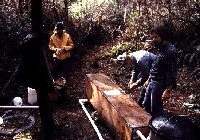 Click on image to enlarge (45K).
Click on image to enlarge (45K).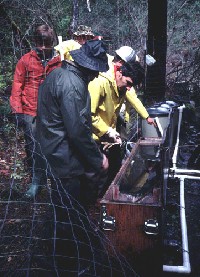 Click on image to enlarge (69K).
Click on image to enlarge (69K).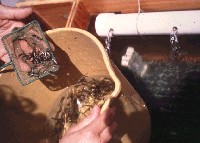 Click on image to enlarge (62K).
Click on image to enlarge (62K).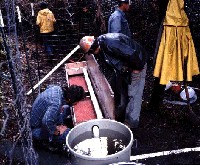 Click on image to enlarge (62K).
Click on image to enlarge (62K).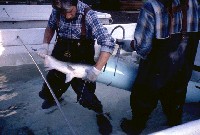 Click on image to enlarge (66K).
Click on image to enlarge (66K).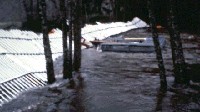 Click on image to enlarge (47K).
Click on image to enlarge (47K).
To learn more about this topic click Info Links
To view additional information (data source, aquisition date etc.) about this page, click Metadata
| www.krisweb.com |
